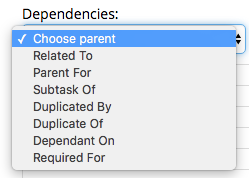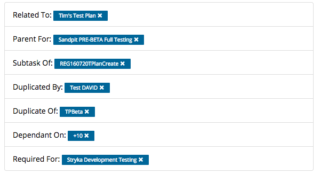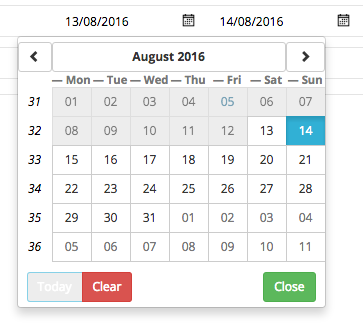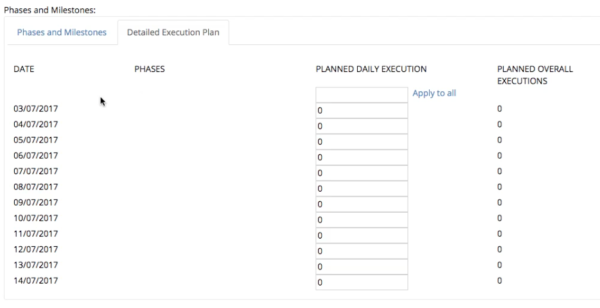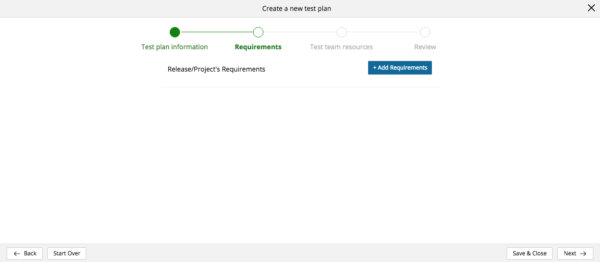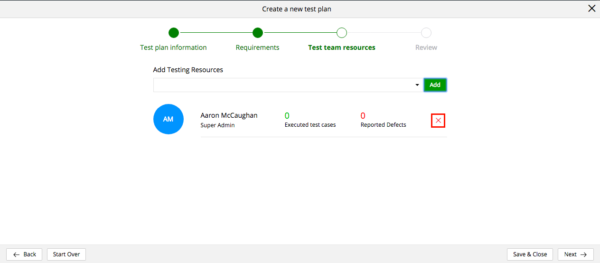The Test Plan page allows users to view, search, and filter their Test Plans. Test Plans serve as containers for your tests.
*NEW* Uploaded attachments are now sorted in descending order by upload date.
Also see how to Filter and Search Test Plans, What The Test Plan Metrics Mean, Duplicate Test Plans, and Delete Test Plans.
Add a Test Plan
To add a manual Test Plan:
- Click Test Plan.

- Click + New Test Plan.
The Create a new test plan pop up opens.

- Type the Test Plan Name. (Mandatory field.)
- Type the Test Plan Description. (Mandatory field.)
- Select a Project from the Project/Release drop-down menu. (Mandatory field.)
Your choice of Project determines the choice of Requirements later under the Requirements tab. - The fields under the Project/Release drop-down menu are custom fields created using the Test Plan Custom Fields Customization. Ask your administrator how to fill them in.
- Manage Dependencies:
A Dependency is a relationship between the Test Plan and another Test Plan. For instance, the Test Plan may be Required For another Test Plan. - Add Phases and Milestones:

- Add a Milestone:
Phases have a start and end date. Milestones only have a single date.- Click + Milestone.
- Click Milestone Name and type the Milestone Name.
- Click Pick a Date and select a date in the calendar drop-down menu.
- Click outside the field to save.
- Add a Phase:
- Delete a Milestone or Phase by clicking the gray X.
Attachments can only be added or managed while editing Test Plans.
- Add a Milestone:
- Click the Detailed Execution Plan tab:
You must create at least one Phase before creating a detailed execution plan because this section breaks down all the Phases into days. Weekend days will be grayed out.
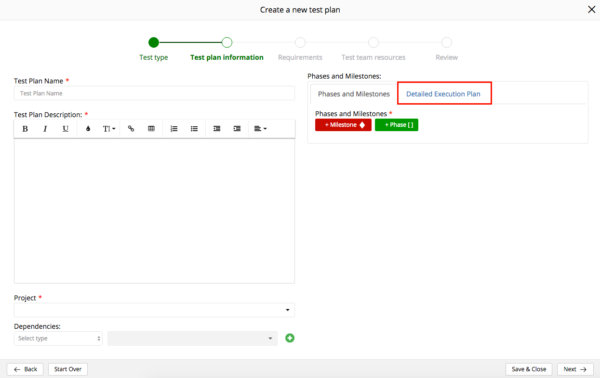
See the results of the Detailed Execution Plan in the Daily Test Progress report.
- Click Next:
- Manage Requirements:
- Add Requirements:
- Click + Add Requirements.

Only Requirements that belong to the Release selected under the Test Plan Info tab will show. - Search for External IDs, Requirement IDs or Requirement Names.
- Click to select Requirement checkboxes.
- Click to select the Select/Deselect All checkbox to speed up the selection processs.
- Click Add Selected.
The Requirements appear under the Project’s Requirements drop-down menu.
- Click + Add Requirements.
- Delete Requirements:
- Add Requirements:
- Click Next.
You will be prompted to confirm whether you wish to add the Test Cases associated with the Requirements you have just selected to the Test Plan.
The Test Team Resources tab opens.
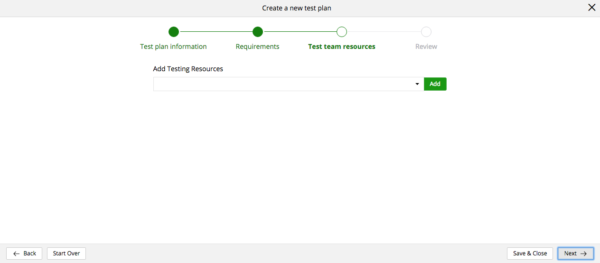
You can currently only select stakeholders as Testing Resources. In the future, software and environments will be selectable. - Manage Testing Resources:
- Click Next.
The Review tab opens.
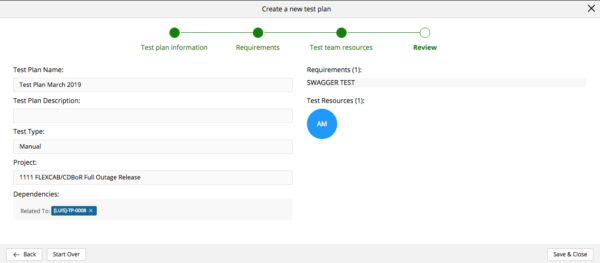
- Review your information. Click the relevant tab to make edits.
- Click Save and Close.
Edit a Test Plan
To edit a manual test plan:
- Click Test Plan.

- Click the Test Plan’s blue-linked ID or Name.
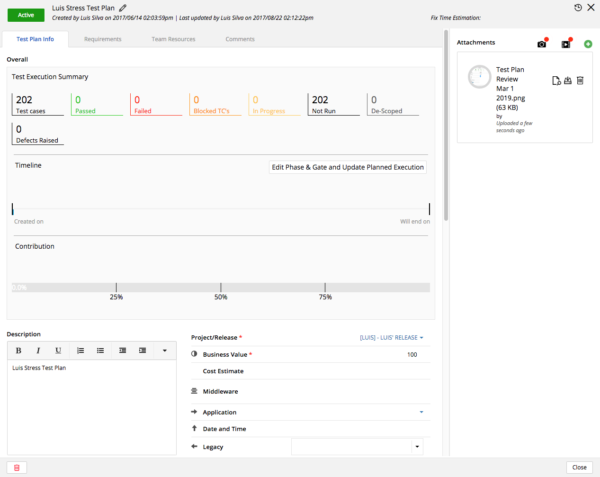
- Make the Test Plan Name editable by clicking the pencil icon.

- Make the Test Plan:
- Active: By clicking the Active button.

Test Plans must be Active to appear in the Test Designer and Test Execution pages. - Inactive: By clicking the Inactive button.

Find out What The Test Plan Metrics Mean.
- Active: By clicking the Active button.
- Manage Phases and Milestones and the Detailed Execution Plan by clicking Edit Phase & Gate and Update Planned Execution next to Timeline:

- Manage Phases and Milestones:
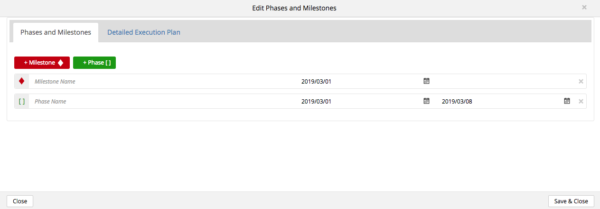
- Add a Milestone:
Phases have a start and end date. Milestones only have a single date.- Click + Milestone.
- Click Milestone Name and type the Milestone Name.
- Click Pick a Date and select a date in the calendar drop-down menu.
- Click outside the field to save.
- Add a Phase:
- Edit a Phase or Milestone by clicking on and editing each field.
- Delete a Milestone or Phase by clicking the gray X.
- Click Save & Close.
- Add a Milestone:
- Manage the Detailed Execution Plan:
See the results of the Detailed Execution Plan in the Daily Test Progress report.- Click the Detailed Execution Plan tab.
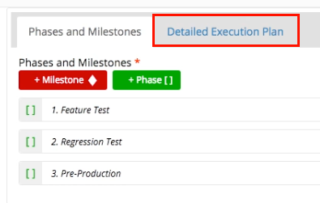
- Select Green, Amber, or Red from the RAG Status drop-down menu.
- Type the Key Points & Highlights. This information will be displayed on the daily progress report.
- Edit the Planned Daily Execution numbers:
- Type the new number of Test Cases that should have been edited on that day.
- Click Save & Close.
- The Detailed Execution Plan shows:
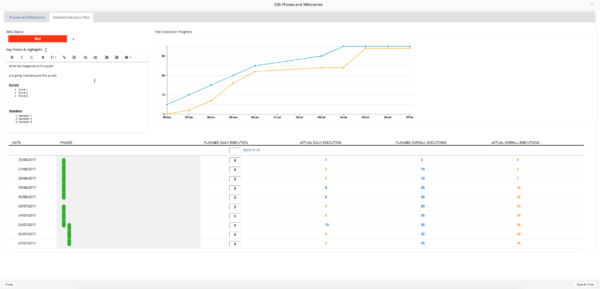
- Test Execution Progress graph.
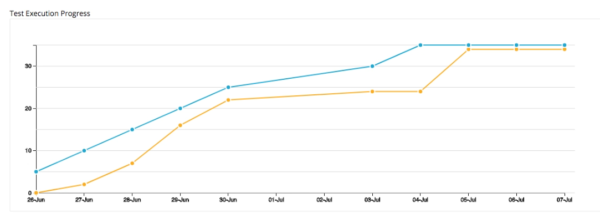
- Planned overall executions (blue) vs Actual overall executions (yellow).
- As Test Cases can be executed multiple times (for example, when a Test Case fails for the first time and must be repeated) the graph will only show the first date that each Test Case is executed.
- Actual overall executions counts Passed, Failed, Blocked, and Descoped Test Cases, but not No Run and In Progress Test Cases.
- Test Cases run outside the Phase dates will not be counted unless the Phase gates are extended.
- Each Phase in green.
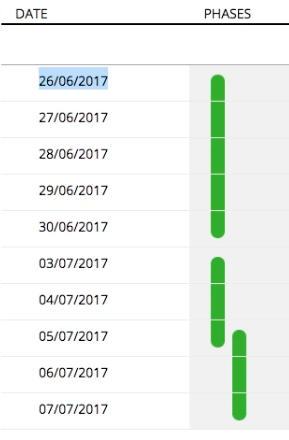
- Weekend dates grayed out.
- Test Execution Progress graph.
- Click the Detailed Execution Plan tab.
- Click Save & Close to return to the Test Plan Info tab.
- Manage Phases and Milestones:
- Edit the Test Plan Description.
- Select a Project from the Project/Release drop-down menu.
Your choice of Project determines the choice of Requirements later under the Requirements tab. - The fields under the Project/Release drop-down menu are custom fields created using the Test Plan Custom Fields Customization. Ask your administrator how to fill them in.
- Manage Dependencies:
A Dependency is a relationship between the Test Plan and another Test Plan. For instance, the Test Plan may be Required For another Test Plan.- Add a Dependency:
- Delete a Dependency.
- Add an attachment using Plutora Test Chrome Plug-In:
To manage attachments, users need the Attachment View / Download, Attachment Access, Attachment Create, and Attachment Delete user permissions.- Add a screenshot:
- Click the black camera icon.

If the camera icon has a red dot, Plutora Test Chrome Plug-In is not installed. Click here to see the installation instructions. (You must also be using Google Chrome browser.) - Manage the screenshot using the toolbar. The tools from left to right are:

- Edit the screenshot title:
- Annotate the screenshot with the following tools:
- Selection: Select and move annotations.

- Crop: Select this tool, draw a rectangle around the area you want to keep, and click Confirm Crop.

- Arrow: Draw an arrow.

Arrows, text, rectangles, ellipses, and free draws will use the color selected in the Color tool (see below). - Text: Click to drop text and click the text to edit.

- Rectangle: Draw a rectangle.

- Ellipse: Draw a circle or oval.

- Free Draw: Draw a line.

- Undo: Undo the last action.

- Redo: Redo the last action.

- Delete: Deletes an annotation that has been selected using the Selection tool.

- Color: Click to select a color for your annotations. The button on the right opens a color wheel so you can select a color that isn’t in the menu.

- Selection: Select and move annotations.
- Click Download to download the file to your computer.
- Click Save to Attachments to save the file to Plutora Test.
- Click the X to close the pop up without saving the screenshot.
- Click the black camera icon.
- Add a video:
Videos created from Plutora Test’s Screen Capture are saved in AWS, meaning that an unlimited number of 25 MB videos can be saved as attachments.- Click the black video icon.

If the video icon has a red dot, Plutora Test Chrome Plug-In is not installed. Click here to see the installation instructions. (You must also be using Google Chrome browser.) - Click to select which application window should record.
- Click Share.
- Click Start Recording.

- Click Stop to end the recording.
- Edit the video title:
- Click Record New Clip to discard the current video and record a new one.
- Click Download to download the file to your computer.
- Click Save to Attachments to save the file to Plutora Test.
Plutora Test can accept attachments up to 25 MB in size. If the video is larger, it cannot be saved as an attachment, but you can still download it. - Click the X to close the pop up without saving the video.
- Click the black video icon.
- Add a screenshot:
- Add an attachment manually:
To manage attachments, users need the Attachment View / Download, Attachment Access, Attachment Create, and Attachment Delete user permissions. - Manage uploaded attachments:
*NEW* Uploaded attachments are now sorted in descending order by upload date.- View an attachment:
- Download an attachment:
- Delete an attachment:
- Click the Requirements tab.
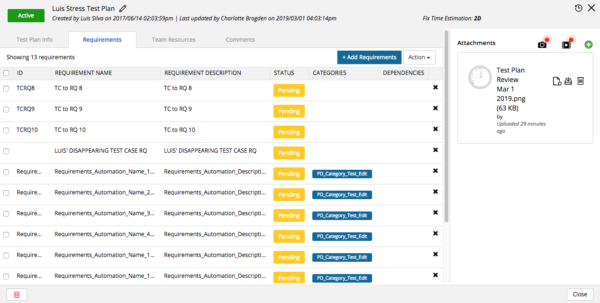
- Manage Requirements:
- Add Requirements:
- Click + Add Requirements.
Only Requirements that belong to the Release selected under the Test Plan Info tab will show. - Search for External ID, Requirement IDs or Requirement Names.
- Click to select Requirement checkboxes.
- Click to select the Select/Deselect All checkbox to speed up the selection processs.
- Click Save & Close.
You will be prompted to confirm whether you wish to add the Test Cases associated with the Requirements you have just selected to the Test Plan.
- Click + Add Requirements.
- Delete a Requirement:
- Click the black X next to the Requirement.
- Bulk delete Requirements:
- Add Requirements:
- Click the Team Resources tab.

- Manage Team Resources:
You can currently only select stakeholders as Testing Resources. In the future, software and environments will be selectable.- Add Testing Resources:
- Select stakeholders from the Showing test resources drop-down menu.
- Delete Testing Resources:
- Click the black X next to the testing resource.
- Add Testing Resources:
- Manage Comments:
To manage comments, users need the Comments View, Comments Create, and Comments Update user permissions.- Click the Comments tab.
- Add a comment by typing your comment in the Your comment… field and clicking Send.
- Click Edit to edit your comment.
- Click Reply to reply to a comment.
- To tag a User, so that your tagged comment appears in their Comment Stream:
- Click Close or click the X at the top right of the pop up.
View Activity History
Click the clock-shaped button ![]() on the top right of the pop up to view the Activity History of the record. To see more information about Activity History, click here.
on the top right of the pop up to view the Activity History of the record. To see more information about Activity History, click here.


